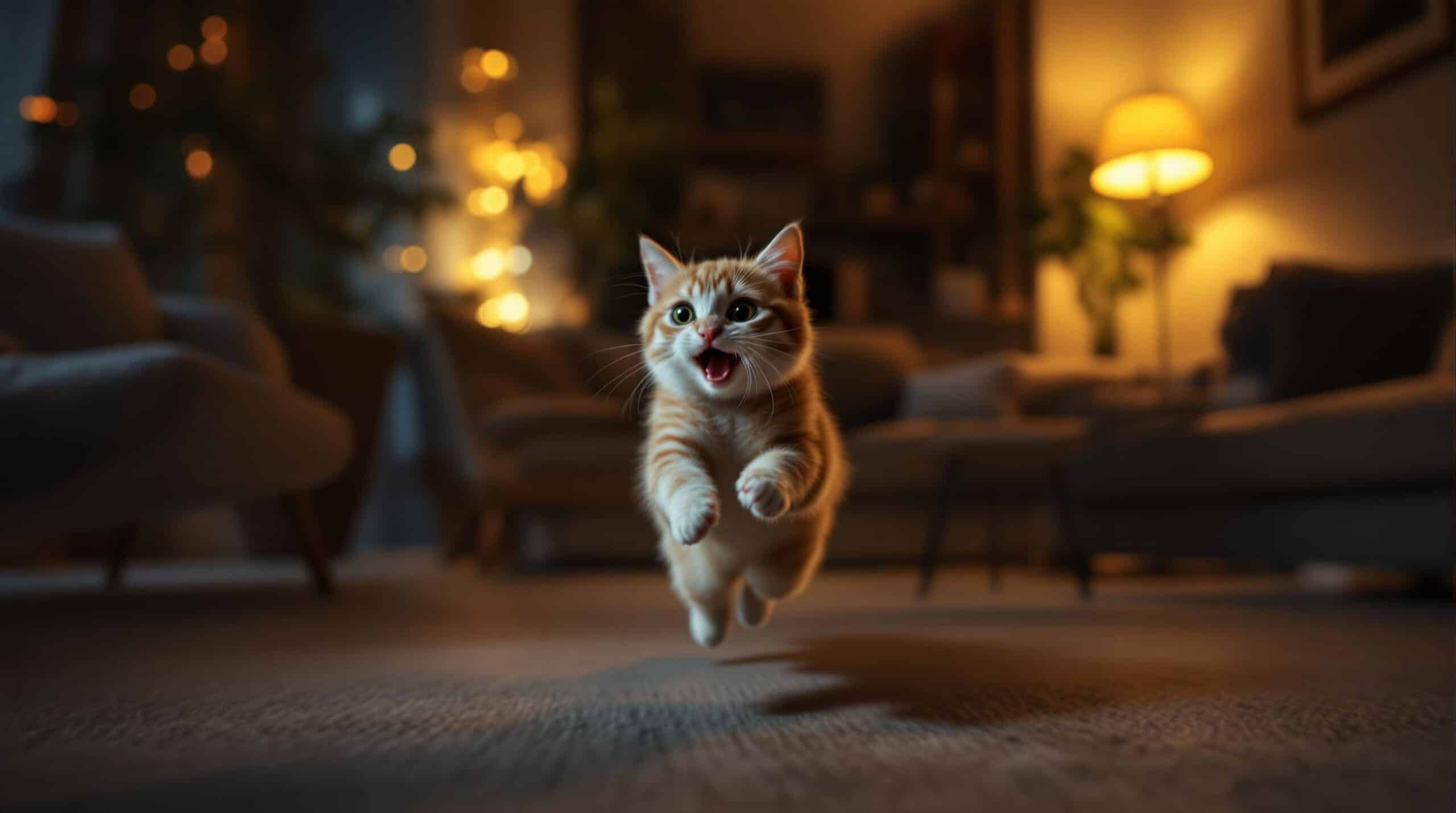Cats zoomies at night can be both amusing and frustrating for pet owners. This article delves into the reasons behind this behavior, offers practical tips for managing it, and highlights the importance of a healthy environment for your feline friend. By understanding the natural instincts and needs of your cat, you can ensure a peaceful and enjoyable living space for both of you. Discover how to create a balanced routine and address any underlying issues that may be contributing to nighttime zoomies.
Why Do Cats Get the Zoomies at Night
Cats are known for their sudden bursts of energy, especially during the nighttime. These bursts, often referred to as ‘zoomies,’ can be both entertaining and disruptive. Understanding the reasons behind these behaviors can help you manage them more effectively.
Natural Hunting Instincts
Cats have evolved as natural hunters, and their nocturnal tendencies are deeply rooted in their history. In the wild, cats would hunt at night when their prey was most active. This instinct still persists in domestic cats, leading to increased activity and energy bursts during the evening and night hours.
Circadian Rhythms and Activity Patterns
Cats are crepuscular animals, meaning they are most active during the twilight hours of dawn and dusk. However, many domestic cats adapt their activity patterns to their owners’ schedules, leading to increased nighttime activity. This can result in the ‘zoomies’ you observe during the night.
Environmental Factors
The environment plays a significant role in a cat’s behavior. A quiet, dark house can provide the perfect setting for a cat to release pent-up energy. Additionally, the absence of competition for resources and the presence of low light can trigger their hunting instincts, leading to bursts of activity.
Common Causes of Cat Zoomies
While the natural hunting instincts of cats contribute to their zoomies, there are several other factors that can influence this behavior.
Diet and Nutrition
The type of food your cat consumes can significantly impact their energy levels. High-energy, protein-rich diets can lead to increased activity, especially if the cat is not getting enough physical exercise. On the other hand, a balanced diet that meets your cat’s nutritional needs can help regulate their energy levels and reduce the occurrence of zoomies.
Exercise and Play
Cats need regular physical activity to stay healthy and burn off excess energy. A lack of exercise can lead to pent-up energy, which is often released in the form of zoomies. Engaging your cat in interactive play sessions, such as chasing toys or using a laser pointer, can help tire them out and reduce nighttime activity.
Stress and Anxiety
Cats are sensitive to their environment and can become stressed or anxious due to various factors, such as changes in the household, the presence of other pets, or a lack of stimulation. Stress and anxiety can manifest in increased activity and zoomies. Creating a calm and stimulating environment can help reduce these behaviors.
Managing Cat Zoomies at Night
Managing cat zoomies at night involves creating a supportive environment and establishing a routine that meets your cat’s physical and emotional needs.
Creating a Play Area
Designate a specific area in your home where your cat can engage in play and physical activity. This area should be safe and free from obstacles that could cause injury. Incorporate toys and climbing structures to provide mental and physical stimulation. Regular play sessions in this area can help your cat burn off excess energy and reduce nighttime zoomies.
Using Calming Aids
Calming aids, such as pheromone sprays, diffusers, and calming treats, can help soothe your cat during periods of high energy. These aids work by mimicking natural pheromones that promote relaxation and reduce anxiety. Using calming aids in conjunction with other management strategies can help create a more peaceful environment for both you and your cat.
Establishing a Routine
Establishing a consistent daily routine can help regulate your cat’s activity levels. This includes regular feeding times, play sessions, and quiet periods. By creating a predictable schedule, you can help your cat feel more secure and reduce the likelihood of nighttime zoomies. Additionally, incorporating a bedtime routine, such as a gentle play session followed by a calming activity, can help signal to your cat that it’s time to wind down.
When to Seek Professional Help
In some cases, cat zoomies may be a sign of underlying health or behavioral issues. If you notice changes in your cat’s behavior or if the zoomies are causing significant disruption, it may be time to seek professional help.
Signs of Health Issues
While occasional zoomies are normal, excessive or sudden changes in behavior can indicate a health problem. Signs to watch for include increased vocalization, changes in appetite, and changes in litter box habits. If you notice any of these signs, consult with your veterinarian to rule out any medical conditions.
Behavioral Consultations
A behavioral consultation with a certified animal behaviorist can provide valuable insights into your cat’s behavior. A behaviorist can help identify the underlying causes of your cat’s zoomies and provide tailored strategies for managing them. They can also offer guidance on creating a supportive environment and establishing a routine that meets your cat’s needs.
Veterinary Advice
Your veterinarian is a valuable resource for addressing any concerns about your cat’s health and behavior. They can perform a thorough examination to rule out any medical issues and provide recommendations for managing your cat’s zoomies. If necessary, they may refer you to a specialist for further evaluation and treatment.
Comparison of Cat Zoomies at Different Times
Understanding the differences between cat zoomies at night, in the morning, and after playtime can help you manage this behavior more effectively. The following table compares the frequency, duration, intensity, common triggers, and management tips for each type of zoomies.
| Feature | Cat Zoomies at Night | Cat Zoomies in the Morning | Cat Zoomies After Playtime |
|---|---|---|---|
| Frequency | High | Moderate | High |
| Duration | 10-30 minutes | 5-15 minutes | 5-20 minutes |
| Intensity | High | Moderate | High |
| Common Triggers | Low light, quiet environment | Sunlight, fresh air | Physical activity, excitement |
| Management Tips | Provide a play area, use calming aids | Establish a morning routine, offer treats | Allow for cool-down time, provide a quiet space |
Popular Quote
“Cats are connoisseurs of comfort.” — Jim Davis
Statistical Fact
According to a study by the American Veterinary Medical Association, approximately 60% of cat owners report that their cats exhibit increased activity levels during the night. This statistic highlights the prevalence of nighttime zoomies and underscores the importance of understanding and managing this behavior. (Source: American Veterinary Medical Association, 2021)
Three Tips for Managing Cat Zoomies at Night
- Interactive Play Sessions: Engage your cat in interactive play sessions in the evening to help burn off excess energy. This can reduce the likelihood of nighttime zoomies and promote a more peaceful environment.
- Calming Aids: Use calming aids such as pheromone sprays or diffusers to help soothe your cat during periods of high energy. These aids can create a more relaxed atmosphere and reduce anxiety.
- Consistent Routine: Establish a consistent daily routine that includes regular feeding times, play sessions, and quiet periods. A predictable schedule can help regulate your cat’s activity levels and reduce the frequency of zoomies.
Popular Questions About Cat Zoomies at Night
- Why do cats get the zoomies at night? Cats are naturally crepuscular, meaning they are most active during the twilight hours. This, combined with their hunting instincts, can lead to increased activity and energy bursts at night.
- How can I reduce my cat’s nighttime zoomies? Provide a play area, use calming aids, and establish a consistent routine. Engaging your cat in interactive play sessions and creating a calm environment can help manage and reduce nighttime zoomies.
- Are cat zoomies a sign of health issues? While occasional zoomies are normal, excessive or sudden changes in behavior can indicate a health problem. If you notice signs such as increased vocalization, changes in appetite, or litter box habits, consult your veterinarian.
Final Thoughts About Cats Zoomies at Night
Understanding and managing cat zoomies at night is essential for a harmonious household. By recognizing the natural behaviors and needs of your cat, you can create a supportive environment that promotes health and happiness. If you have any concerns or need further assistance, don’t hesitate to reach out to a professional. Visit our website to find excellent gifts for cat lovers and follow us on social media for more tips and updates.
- Understand the natural instincts behind cat zoomies and how they relate to hunting behaviors.
- Create a safe and stimulating environment that encourages healthy play and exercise.
- Establish a consistent routine to help manage and reduce the frequency of cat zoomies.
- Use calming aids and techniques to soothe your cat during periods of high energy.
- Monitor your cat’s diet and health to ensure they are getting the necessary nutrients and care.
- Engage in interactive play sessions to help burn off excess energy and promote bonding.















